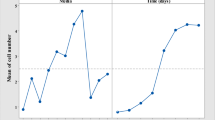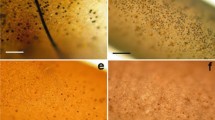Abstract
In order to study saxitoxin (STX) production bymicro-algae in the laboratory, a defined algal culture medium which supports optimum growth over a longtime-period is a requirement. In the development of such a medium, a number of modifications were made to a standard algal culture medium (GP) and growth of a STX-producing isolate of Alexandrium minutum in the different formulations was assessed by measuring maximum cell densities and mean generation times (MGT). All experiments were carried out under controlled conditions in an aerobic atmosphere with increased CO2. Whilst maximum cell densities in the different modifications were similar, the MGT was significantly shortened by the addition of Tris buffer and the trace metals strontium, selenium and molybdenum. Replacement of natural with artificial seawater and removal of soil extract did not adversely affect algal growth. Five of the six media formulations supported the growth of A. minutumover a 9-month period.
Similar content being viewed by others
References
Anderson DM (1978) The role of chelators and trace metals in toxic blooms. In Taylor DL, Seliger HH (eds), Proceedings of the Second International Conference on Toxic Dinoflagellate Blooms. Key Biscayne, Florida, October 31-November 5, 1978, Elsevier Science, pp. 463-467.
Atlas RM, Bartha R (1987) Microbial Ecology: Fundamentals and Applications. Benjamin/Cummings Pub. Co. Inc, 284 pp.
Bower DJ, Hart RJ, Matthews PA, Howden MEH (1981) Nonprotein neurotoxins. Clin. Toxicol. 18: 813-863.
Fábregas J, Vázquez V, Cabezas B, Otero A (1993) Tris not only controls the pH in microalgal culture, but also feeds bacteria. J. appl. Phycol. 5: 543-545.
Loeblich AR, Smith VE (1968) Chloroplast pigments of the marine dinoflagellate Gyrodinium resplendens. Lipids 3: 5-13.
MacKenzie L, Berkett N (1997) Cell morphology and PSP-toxin profiles of Alexandrium minutum in the Marlborough Sounds, New Zealand. N. Z. J. mar. Freshwat. Res. 31: 403-409.
Provasoli L (1958) Nutrition and ecology of protozoa and algae. Ann. Rev. Microbiol. 12: 279-308.
Siegelman H (1978) Culturing of dinoflagellates. In Taylor DL, Seliger HH (eds), Proceedings of the Second International Conference On Toxic Dinoflagellate Blooms. Key Biscayne, Florida, October 31-November 5, 1978, Elsevier Science, pp. 471-472.
Thiele J, Honer-Schmid O, Wahl J, Kleefeld G, Schultz JE (1980) A new method for axenic mass cultivation of Paramecium tetraurelia. J. Protozool. 27: 118-121.
Author information
Authors and Affiliations
Rights and permissions
About this article
Cite this article
Maas, E.W., Thiele, J., Thompson, C. et al. Modification of an algal culture medium for sustained growth of a saxitoxin-producing isolate of Alexandrium minutum . Journal of Applied Phycology 12, 95–98 (2000). https://doi.org/10.1023/A:1008137303135
Issue Date:
DOI: https://doi.org/10.1023/A:1008137303135




